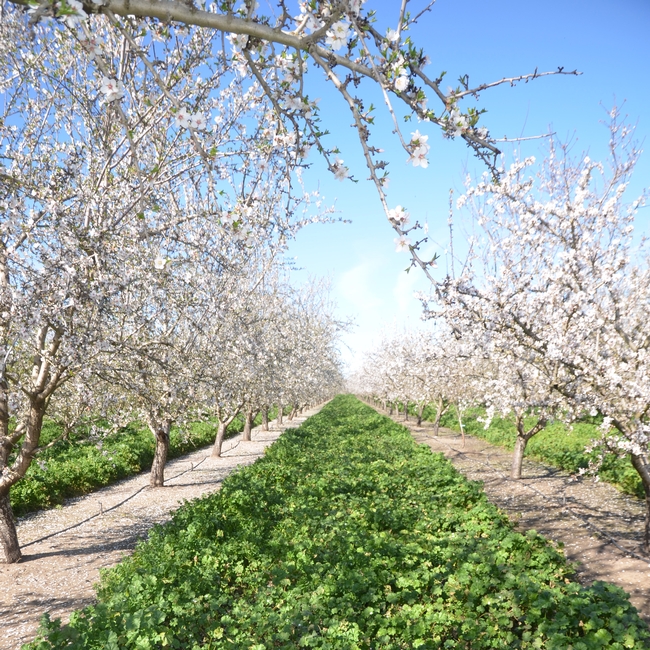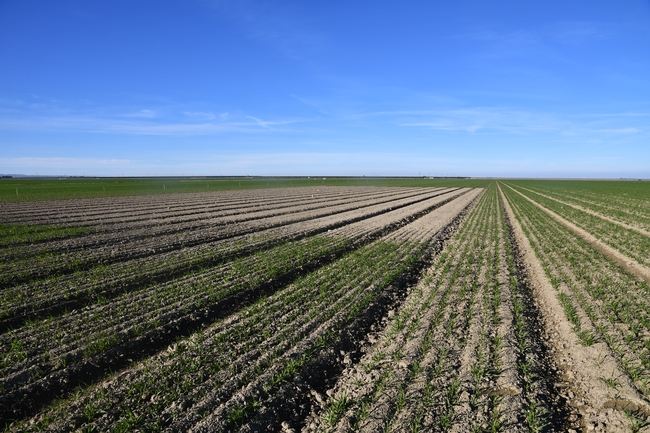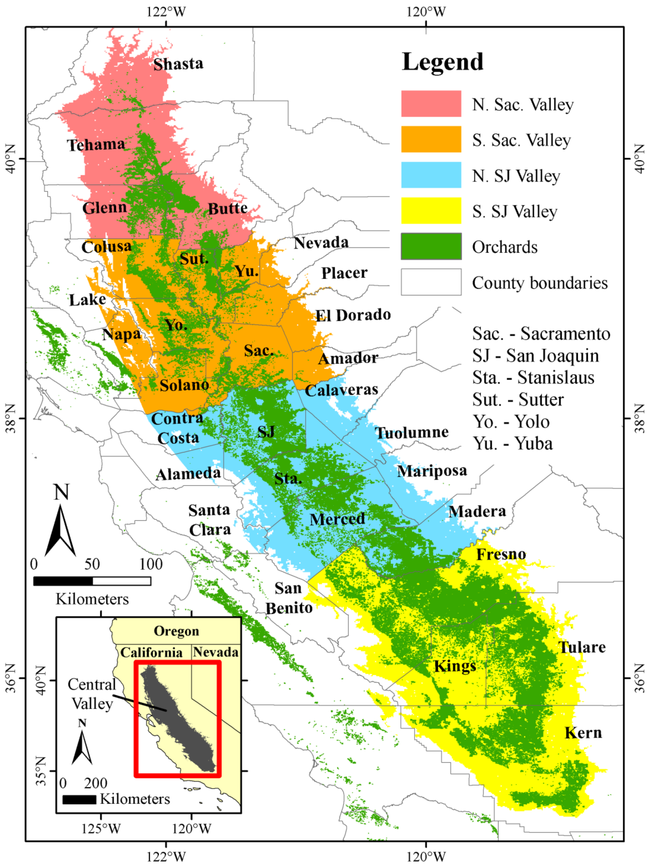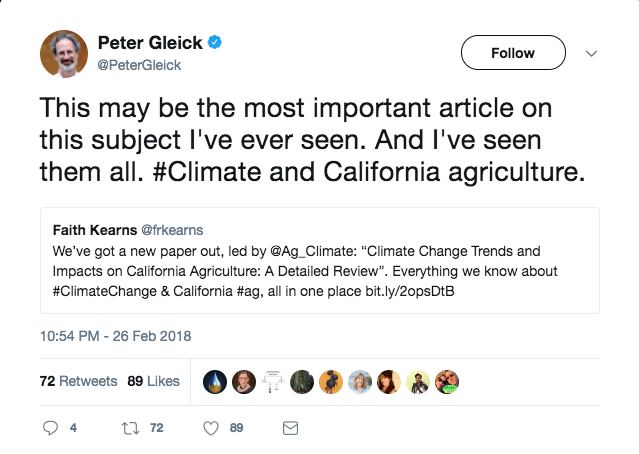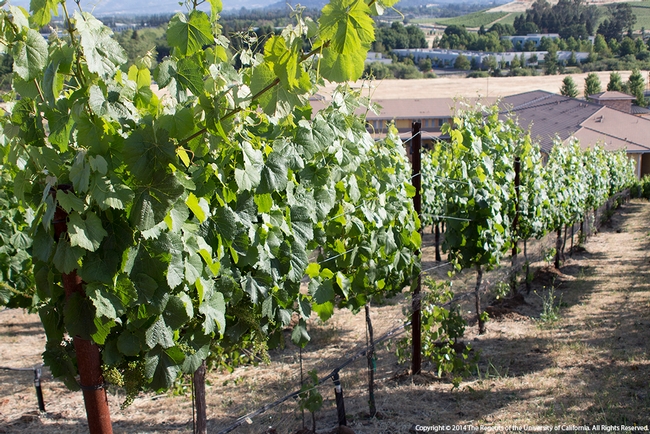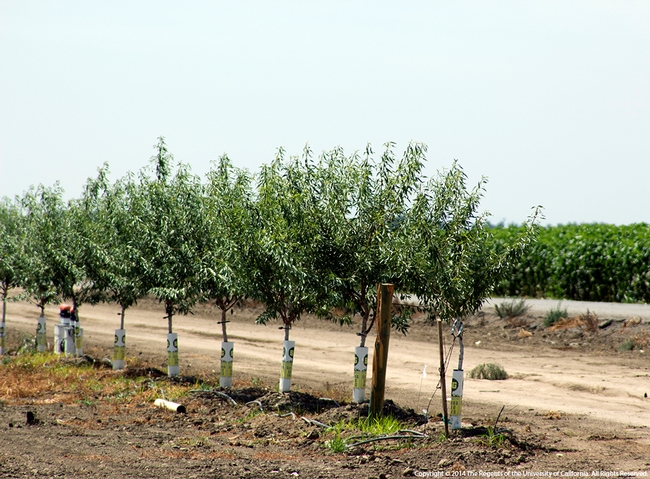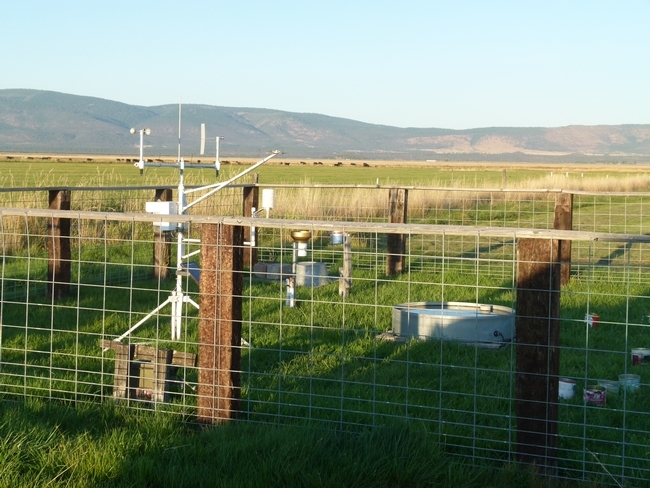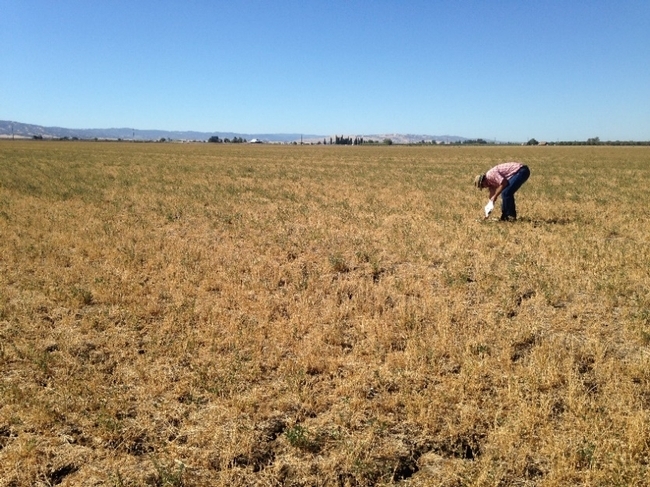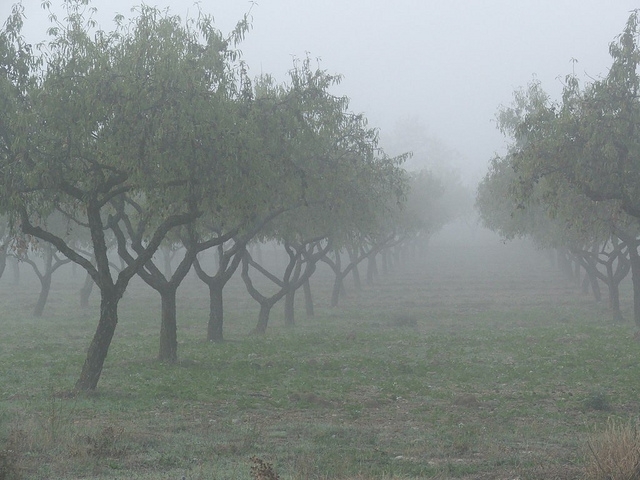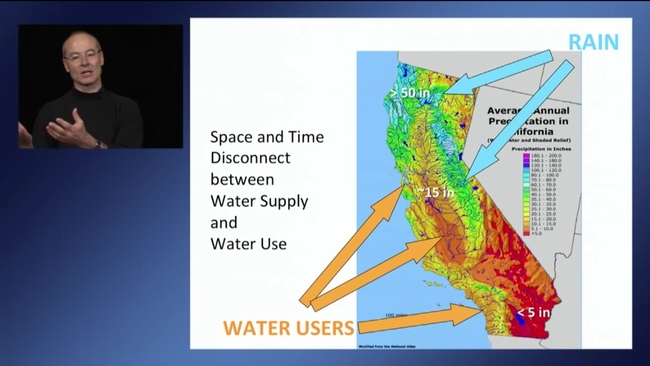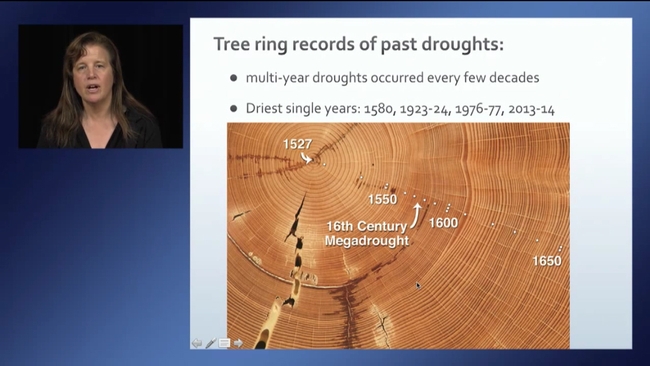Posts Tagged: Daniele Zaccaria
New cover crop research can help groundwater sustainability agencies plan
Cover crops seem to offset their water use by improving soil moisture retention
Cover crop research conducted by a team of university researchers is now helping to inform and shape policy to implement the Sustainable Groundwater Management Act (SGMA) in several San Joaquin Valley counties.
“The Madera County Regional Water Management Group appreciates continued scientific discussions on SGMA-related issues, and especially enjoyed hearing from researchers on cover crops,” said Tom Wheeler, chair of the Regional Water Management Group for Madera County and a Madera County supervisor. “This is work that should be helpful to growers as they evaluate cover crops as part of their sustainable future.”
To help protect groundwater resources over the long-term, groundwater sustainability agencies (GSAs) are developing groundwater sustainability plans for their local regions.
"Our findings suggest that cover crop water use is negligible in most water years and the long-term benefits can help GSAs meet their management goals,” said Alyssa DeVincentis, a former UC Davis Ph.D. student who worked on the project. “How cover crops impact soil moisture depends on species and management history, but generally soil moisture at the end of the winter season did not differ between fields with winter cover crops and clean cultivated soils."
From 2016 through 2019, UC Agriculture and Natural Resources researchers and their collaborators amassed very large data sets from almond orchard and tomato field sites located between Chico in Butte County and Arvin in Kern County. They used the data to quantify changes in soil water storage and evapotranspiration that occur under cover-cropped and bare fallow conditions during the winter cover crop growing period – about November to March.
The research team includes UC Cooperative Extension water specialists Daniele Zaccaria, Samuel Sandoval-Solis and Jeff Mitchell based at UC Davis; DeVincentis now of Vitidore, Inc.; and Anna Gomes, Ph.D. student at Stanford University.
The GSAs must first quantify the amount of water going into the groundwater bank through rainfall and surface water irrigation versus the amount of groundwater being removed at all farms within the GSA's jurisdiction.
“To do this, many local GSAs are turning to remote sensing and modeling of evapotranspiration, or ET, to provide data on the regional balance between groundwater depletions versus recharges,” Mitchell explained.
“Because winter cover crops may appear on remote sensing images as water-using vegetation, the sole use of model-driven data coming from satellites could become a disincentive to the practice being used.”
“This approach may not account for the important benefits that winter cover crops provide San Joaquin Valley farmers like Justin Wylie, a Madera County almond and pistachio grower who works with the research team,” Mitchell said. “He has experienced the benefits of winter cover crops firsthand, including increased water infiltration, habitat and carbon for soil organisms, and reduced water run-off.”
Cover crops grown during the winter may not use a lot of soil water because ET during this period tends to be low. They also provide shading and soil surface cooling, which help reduce soil evaporation. In addition, Mitchell said that cover crops can improve soil aggregation, pore space and soil moisture retention.
Together, cover crop benefits seem to offset or compensate for their actual water use during the winter.
“Because GSAs need reliable and accurate information related to this important issue and to possible shortcomings of relying solely on remote sensing as the way to go, our research has been particularly timely in the context of SGMA,” said Daniele Zaccaria, associate professor and water management specialist in UC Cooperative Extension at UC Davis.
A presentation about their cover crops research is available on YouTube at https://youtu.be/x3xQlZ9EdCk. The webinar is intended for water agency personnel, but the information is relevant to anyone who is interested in how cover crops may influence San Joaquin Valley cropping systems and the water cycle, Mitchell said.
A peer-reviewed article about this cover crop research, “ “Impacts of winter cover cropping on soil moisture and evapotranspiration in California's specialty crop fields may be minimal during winter months,” will appear in the first quarterly issue of California Agriculture in 2022.
California agriculture industry must act now to adapt to climate change
"This article received more than 1000 views in less than a day," Pathak wrote in an email to colleagues.
The review article summarizes historical and future climate trends and their impacts on California agriculture. The authors also suggest adaptation and mitigation strategies.
Shortly after Kearns, California Institute for Water Resources academic coordinator, tweeted, “We've got a new paper out, led by @Ag_Climate: “Climate Change Trends and Impacts on California Agriculture: A Detailed Review”. Everything we know about #ClimateChange & California #ag, all in one place http://bit.ly/2opsDtB,” journalists took notice.
“Climate change could decrease the yield of some crops in the state by up to 40 percent by 2050. That's a big deal for farmers growing more than 400 commodities,” Ezra Romero of Capital Public Radio reported. “Tapan Pathak, a UC Cooperative Extension specialist based in Merced, and his research team analyzed more than 90 studies on climate change and discovered that warming temperatures may alter where crops grow across California. Their findings were published in Agronomy Journal.
“In order to make California agriculture more sustainable we have to act now,” Pathak said.
Ian James of the Desert Sun spoke with Kearns. “One under-appreciated aspect of California's climate is how important our temperature envelope is to California's agricultural sector. The right temperatures at the right times are absolutely crucial,” said Faith Kearns, a scientist with the California Institute for Water Resources who was part of the team. “For example, warm weather in January and February can reduce almond yields, but warm summers can reduce peach yields. So, there really is no-one-size-fits-all adaptation approach.”
In her report for KQED, Amel Ahmad noted, “Climate scientist and author Peter Gleick called it the most important report he's seen on the impact of climate change on California agriculture.”
The study was also covered in Courthouse News Service by Nick Cahill, Think Progress by Natasha Geiling, Digital Journal by Karen Graham, Grist by Nathanael Johnson, NPR by Ezra Romero, Modern Farmer by Dan Nosowitz and Fresno Bee by Brianna Calix.
This study was supported by the UC President's Carbon Neutrality Initiative and UC ANR.
What can California, Israel and Australia learn from each other about drought?
Drought management experts from Israel and Australia will join U.S. scientists in California for a workshop in Modesto on Jan. 12 and 13. Growers, crop consultants, irrigation practitioners, state agency members and others are invited to participate.
The two-day event, “Proven Solutions to Drought Stress: Water Management Strategies for Perennial Crops with Limited and Impaired Water Supplies,” is designed to foster conversation on a variety of drought management aspects and strategies. The drought workshop will be held at the Modesto Centre Plaza at 1150 9th Street in Modesto.
“California, Israel and Australia have all faced recurring drought conditions of varying severity and duration,” said James Ayars, research agricultural engineer of USDA Agricultural Research Service in Parlier, Calif., who spearheaded the event to bring together this prestigious group of scientists. “In view of more frequent and more severe recurring droughts in the years to come, it makes sense for us to pool our knowledge and plan more strategically for the future.”
Over the past 20 years, USDA and University of California scientists have developed several new approaches to help growers adapt to using water more efficiently. Several UC Davis, UC Cooperative Extension and California Department of Water Resources scientists will discuss their research approach and findings in California.
Other speakers include Shabtai Cohn, head of Israel's Agricultural Research Organization Soil, Water and Environmental Sciences Institute, John Hornbuckle, associate professor at Deakin University in Australia, and other researchers from Israel and Australia.
This workshop is sponsored by the USDA Agricultural Research Service, UC Agriculture and Natural Resources (UC ANR), UC California Institute for Water Resources and the Israel Ministry of Agriculture's Agricultural Research Organization.
“We hope to share expertise gained from experiences in our respective countries and learn new approaches for growing crops with limited water and poor quality water under the prospect of increased climate variability and change,” said Daniele Zaccaria, UC ANR Cooperative Extension specialist in agricultural water management in the Department of Land, Air and Water Resources at UC Davis and one of the event organizers. “Although Australia and Israel have very different climatic and socioeconomic conditions, there may be drought management strategies and policies that work in California that they can apply, and they may have practices and policies that we can adapt to address issues in California.”
Registration is $80 and includes lunch for both days. Dec. 18 is the deadline for early registration. After Dec. 18, registration is $120 until Jan. 1, 2016, and $150 after Jan. 1. There will be no on-site registration.
Certified crop advisers can earn continuing education units: Soil & Water Management 12.0 CEU and Crop Management 0.5 CEU.
To see the agenda and to register, please visit http://www.droughtmgt.com.
Lodging is available next to the Modesto Centre Plaza at the DoubleTree Hotel at 1150 9th Street in Modesto.
Drought tips available for farmers
Drought strategies for managing alfalfa and many other crops are available free from UC Agriculture and Natural Resources. As California endures a fourth year of drought and ever-tightening water supplies, water-management strategies have become even more critical to farmers.
To help farmers make the best use of the water they have available, a series of new and updated drought tips fact sheets has been developed by UC ANR scientists and funded by the California Department of Water Resources.
“These drought tips provide irrigation management recommendations for a broad range of agricultural crops and under different water supply conditions,” said Daniele Zaccaria, UC ANR Cooperative Extension agricultural water management specialist at UC Davis and major organizer of the drought tip series. “The information in these tips will be of practical use for growers and other water-related stakeholders now and into the future as our agricultural community continues to adapt to climate variability and to a changing water supply situation.”
UC ANR scientists have identified best management practices for a wide range of annual and permanent crops and irrigation systems and methods during the drought. In the drought tips series, they also give advice for managing soil salinity and using shallow groundwater for irrigating crops. For beef cattle, they provide recommendations for culling herds and feeding to supplement grazing.
The following drought tips are currently available for free download at http://ucanr.edu/drought-tips:
- Drought strategies for alfalfa
- Drought management for California almonds
- Use of shallow groundwater for crop production
- Drought strategies for walnuts
- Fog contribution to crop water use
- Reclaiming Saline, Sodic and Saline-Sodic Soils
Decades of UC ANR research underlie the information contained in the drought tips. In the 1970s and again in the 1990s, UC ANR partnered with DWR to develop a series of drought management fact sheets.
“DWR has worked with UC ANR to update the drought tips and make sure the latest and best information on water management is available to growers,” said Peter Brostrom, DWR Water Use Efficiency Section Manager.
The California Institute for Water Resources, which coordinates water-related research and extension education across the 10 UC campuses and UCANR, has the drought tips and more drought resources online at http://ciwr.ucanr.edu.
“Even if El Niño brings rain this fall, water scarcity will continue to impact California farmers,” said Doug Parker, director of UC ANR's California Institute for Water Resources. “As climate change continues to reduce the average annual snowpack, it is likely that droughts in California will become more frequent and severe in the years to come.”
UC ANR's California Institute for Water Resources and the California Department of Water Resources also offer drought-related information in a series of videos. Water experts from UC and other agencies and institutions have recorded presentations on high-priority drought topics. Currently 38 videos can be accessed for free on computers and mobile devices at http://ucanr.edu/insights.
UC Agriculture and Natural Resources researchers and educators draw on local expertise to conduct agricultural, environmental, economic, youth development and nutrition research that helps California thrive. Learn more at ucanr.edu
Too wet outside to work? Watch a drought video
Rain has begun falling, but California continues to operate under severe water scarcity from low precipitation over the past three years.
“California will need about 150 percent of normal rainfall this winter to end the drought,” said Doug Parker, director of UC California Institute of Water Resources. “Although the rains have come, we can't afford to let our attention drift away from carefully managing our water supply.”
The UC California Institute of Water Resources, with support from the California Department of Water Resources, has recorded presentations by scientists in the UC system and other organizations on a variety of topics related to water management and drought. “Insights: Water and Drought Online Seminar Series” is accessible by computer or mobile device.
The online seminars enable UC Cooperative Extension and the other scientists to share their knowledge with a larger audience than those who can attend meetings in person, said Daniele Zaccaria, UC Cooperative Extension specialist in agricultural water management in the Department of Land, Air and Water Resources at UC Davis.
“Farmers, landscape professionals, land managers, irrigation consultants, resource managers from water districts and others can view the half-hour video presentations on YouTube whenever it is convenient for them, obtaining science-based information that stems from applied research conducted by several scientists over the last 10 to 15 years,” said Zaccaria, who coordinates the speaker series.
Topics include drought impacts on natural resources, drought preparedness, water management in urban landscapes during a drought and crop management with limited water.
Currently 39 videos addressing drought and water management in different settings are available, and more talks will be added in the coming months. The videos are also being used by Cooperative Extension in other states and have been viewed hundreds of times. “Groundwater and surface water interactions under water shortage,” by Thomas Harter, UC Cooperative Extension specialist in the Department of Land, Air and Water Resources at UC Davis, has been viewed nearly 1,400 times and “Climate change and paleoclimatology: 2013/2014 in perspective” by Lynn Ingram, professor in the Department of Earth and Planetary Science at UC Berkeley, has been more than 800 times.
The following titles have recently been added:
Water resources management in the Pajaro Valley, California
Brian Lockwood, senior hydrologist, Pajaro Valley Water Management Agency
Managing corn under California's drought conditions
Mark Lundy, UC Cooperative Extension advisor in Sutter, Yuba and Glenn counties
Droughts, climate change, and dams: Reconciling a future for California's native inland fishes
Peter Moyle, professor in the Department of Wildlife, Fish & Conservation Biology at UC Davis
Managing landscapes on limited water
Loren Oki, UC Cooperative Extension specialist in the Department of Plant Sciences at UC Davis
Drought - An insidious stress on wildlife
Greg Giusti, UC Cooperative Extension advisor, forests and wildland ecology in Mendocino County
Agricultural water management practices under limited water supply: Lessons from recent droughts
James E. Ayars, agricultural engineer, USDA-ARS
Soil moisture monitoring and utilization during a drought
Dan Munk, UC Cooperative Extension advisor, irrigation, soils and cotton in Fresno County
Land subsidence along the Delta-Mendota Canal and neighboring areas
Michelle Sneed, California Water Science Center, US Geological Survey
How to save water and beautify your landscape ... the sustainable way
Janet Hartin, UC Cooperative Extension advisor, environmental horticulture in San Bernardino and Los Angeles counties
Efficient citrus irrigation
Blake Sanden, UC Cooperative Extension advisor, irrigation and soils in Kern County
Using agroecological practices to enhance the resilience of organic farms to drought
Miguel A. Altieri, professor in the Department of Environmental Science, Policy and Management, UC Berkeley
The drought videos are available at http://ucanr.edu/insights and https://www.youtube.com/UCANR.

